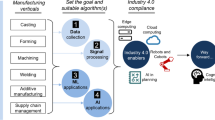Abstract
The integration of manufacturing and service industry has become the mainstream trend. During the manufacturing process, CNC machine tools, as large-scale and complex equipment, involve a variety of service demands in the life cycle, especially the productive service demands are numerous and scattered. The article established the correlation model between customer demands and productive service demands based on clustering ideas and mathematical statistics theory to complete the modularization of productive service demands for CNC machine tools. A comprehensive correlation coefficient model and an improved AP clustering algorithm were put forward. The comprehensive correlation coefficient model mined the correlation between customer demand and production service demand and the self-correlation of production service demands directly based on the combination weight obtained by the analytic hierarchy process and rough set theory. The improved AP clustering algorithm was the combination of AP and Kruskal minimum tree principle. By this new algorithm, the clustering project of productive service demands for every customer demand could be attained. Finally, the five matrices can be computed in 1083 ms, 1067 ms, 1029 ms, 1149 ms and 1042 ms, respectively, by the improved AP clustering algorithm. However, the original AP method should spend 1122 ms, 1241 ms, 1231 ms, 1383 ms and 1231 ms, respectively. So it was very clear that the improved AP clustering algorithm can improve the data processing efficiency.









Similar content being viewed by others
References
Tao Y, Wei J (2015) Context, baseline and prospects of service modularization research: analysis based on foreign literature. Foreign Econ Manag 37(1):43–51
Singh J, Sharan A (2017) A new fuzzy logic-based query expansion model for efficient information retrieval using relevance feedback approach. Neural Comput Appl 28(9):2557–2580
Li H, Ji YJ, Gu XJ, Qi GN, Tang RZ (2012) Module partition process model and method of integrated service product. Comput Ind 2(15):298–308
Song WY, Wu ZY, Li XZ, Xu ZT (2015) Modularizing product extension services: an approach based on modified service blueprint and fuzzy graph. Comput Ind Eng 3(13):186–195
Sheng ZQ, Liu CS, Song JY (2015) Module division and configuration modeling of CNC product-service system. J Mech Eng 21(41):109–113
Xiao YQ, Zhao H, Qiao DQ, Li H, Wang L (2013) Hierarchical module division method based on product services flow. Comput Integr Manuf Syst 19(11):2714–2724
Antle JM, Basso B, Conant RT, Godfray HCJ, Jones JW (2017) Towards a new generation of agricultural system data, models and knowledge products: design and improvement. Agric Syst 155:255–268
Song B, Yoon B, Lee C, Park Y (2017) Development of a service evolution map for service design through application of text mining to service documents. Clean Technol Environ Policy 28(2):251–273
Sousa-Zomer T, Cauchick T, Miguel PA (2017) A QFD-based approach to support sustainable product–service systems conceptual design. Int J Adv Manuf Technol 88(1–4):701–717
Gologlu C, Zurnaci E (2016) An approach for handling individual customer preferences and emotional needs—yielding 3D product assembly generation. Proc Inst Mech Eng Part C J Mech Eng Sci 230(20):3706–3724
Zine PU, Kulkarni MS, Ray AK, Chawla R (2016) Designing flexible service systems: application to machine tools. J Intell Manuf 27(6):1237–1259
Rezapour S, Allen JK, Mistree F (2016) Reliable product–service supply chains for repairable products. Transp Res Part E Logist Transp Rev 95:299–321
Dong HH, Wang WW, Liu MM, Huang L (2017) Modular design of personalized customization model. Packag Eng 38(6):129–133
Liu H (2017) Key technology design of cloud modular product manufacturing service platform. Bull Sci Technol 33(2):113–116
Zhang F (2018) Modula configuration of service elements based on the improved K-means algorithm. Expert Syst 2018:1–17
Ren HY, He S, Chen WL (2017) Application of modified K-means clustering algorithm in image segmentation. Commun Technol 50(12):2704–2707
Roy DK, Sharma LK (2010) Genetic K-means clustering algorithm for mixed numeric and categorical data sets. Int J Artif Intell Appl 1(2):23–28
Sano AVD, Nindito H (2016) Application of K-means algorithm for cluster analysis on poverty of provinces in Indonesia. Comput Technol 7(2):141–150
Haut JM, Paoletti M, Plaza J, Plaza A (2017) Cloud implementation of the K-means algorithm for hyper-spectral image analysis. J Supercomput 73(1):514–529
Sun YH, Li QY, Ding Y, Quan SL, Guan CL, Yang DS, Hu P (2017) County power grid evaluation system based on principal component analysis and hierarchical cluster analysis. Power Syst Prot Control 45(8):30–35
Jiang SY, Yang BH, Wang LX (2015) An adaptive dynamic community detection algorithm based on incremental spectral clustering. ACTA Autom Sin 41(12):2018–2025
Luo T, Zheng XW, Xu GL, Fu K (2017) An improved DBSCAN algorithm to detect stops in individual trajectories. ISPRS Int J Geo Inf 6(3):63
Guo XJ, Chen Y (2013) Analysis and application on AP clustering algorithm. J Jilin Jianzhu Univ 30(4):58–61
Al Hasib A, Cebrian JM, Natvig L (2018) A vectorized K-means, algorithm for compressed datasets: design and experimental analysis. J Supercomput 3:1–24
Wang ZJ, Zhan ZH, Lin Y, Yu WJ, Yuan HQ, Gu TL (2017) Dual-strategy differential evolution with affinity propagation clustering for multimodal optimization problems. IEEE Trans Evolut Comput 99:1
Sayed GI, Hassanien AE, Azar AT (2019) Feature selection via a novel chaotic crow search algorithm. Neural Comput Appl 31(1):171–188
Yang C, Tan YL, Bruzzone L (2017) Discriminative feature metric learning in the affinity propagation model for band selection in hyperspectral images. Remote Sens 9(8):1–16
Jiang J, Wang ZF, Chen TM, Zhu CC, Chen B (2015) Adaptive AP clustering algorithm and its application on intrusion detection. J Commun 36(11):118–126
Acknowledgements
This research was supported by the National Natural Science Foundation of China (Grant No. 51305417).
Author information
Authors and Affiliations
Corresponding author
Ethics declarations
Conflict of interest
The author confirms that this article content has no conflict of interest.
Additional information
Publisher's Note
Springer Nature remains neutral with regard to jurisdictional claims in published maps and institutional affiliations.
Rights and permissions
About this article
Cite this article
Zhang, F., Ding, H. & Zhang, N. Productive service demands modularization for CNC machine tools based on the improved AP clustering algorithm. Neural Comput & Applic 32, 1567–1579 (2020). https://doi.org/10.1007/s00521-019-04173-1
Received:
Accepted:
Published:
Issue Date:
DOI: https://doi.org/10.1007/s00521-019-04173-1




